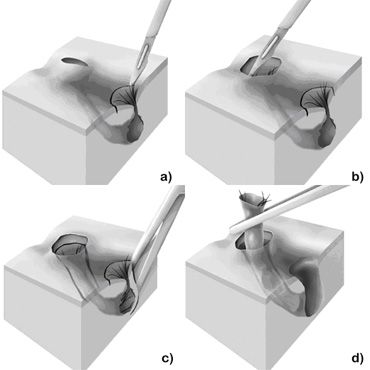Surgery
In the case of an acute pilonidal sinus associated with an infection and an abscess, rapid emergency surgery is necessary. There are various surgical techniques, for example:
- In the case of a small abscess, it is sometimes sufficient to simply open it and allow the pus to drain.
- The surgeon surgically excises the entire pilonidal sinus with a scalpel.
- The abscess is first opened to allow the pus to drain. A few days later, the doctor cuts out the coccyx fistula completely. The advantage of this surgical technique is that the inflammation can initially subside a little and the tissue swells. This should reduce the risk of the disease developing again.
Doctors also operate on a chronic pilonidal sinus, but they have more time available and can plan the operation better. There are various surgical procedures for this, which involve small incisions (minimally invasive) or larger incisions.
Pit-picking
This method works via small incisions in the skin, i.e. minimally invasive or “keyhole surgery”. Only a local anesthetic is required, not a general anesthetic. In pit picking, surgeons attempt to cut out (“pick”) the fistula tracts in the gluteal fold (“pits”). This results in wounds only a few millimeters in size. The fistulas then close due to scarring. The inflammation under the skin also heals. The method is suitable for smaller abscesses and patients who have not yet undergone surgery for this reason. However, pit-picking carries the risk of relapse (approx. ten to 20 percent)
Sinusectomy
Here, surgeons also work minimally invasively under regional anesthesia. They remove individual fistula tracts that originate from the primary opening. The wound remains open and heals. Sinusectomy is suitable for smaller abscesses. According to the literature, it has a lower risk of relapse of around seven percent.
Removal of the coccyx fistula
The removal of coccyx fistula (chronic pilonidal sinus) is performed at our clinic according to a new concept. The coccyx fistula is first marked by injecting blue dye into the skin openings (primary pori). The skin openings are then cut out very sparingly.

Sparing excision of the coccyx fistula
The blue-stained fistula in the subcutaneous fatty tissue is removed just as sparingly. This very sparing removal of tissue results in smaller wounds that are easier to care for and heal more quickly. This operation can be performed on an outpatient basis and under local anesthesia. The risk of the coccyx fistula recurring is less than 10% with this method. This new concept and our good results clearly contradict the techniques that are still frequently used, in which the coccyx fistula is cut out over a large area with correspondingly long healing times. We recently published the data from our new technology in a specialist journal.
In our opinion, techniques that close the skin directly after removal should no longer be performed, as they are associated with higher recurrence rates (risk of the coccyx fistula returning). In our opinion, it is also no longer necessary to cut away very large areas of tissue, as was previously the case. This can prevent long wound healing times and reduce the duration of incapacity for work. In the case of large findings or the occurrence of coccyx fistulas after surgery, skin closure with a tissue flap is a very good alternative to open wound treatment (so-called Limberg flap). In this technique, the resulting tissue defect is covered with a tissue flap so that there is no open wound at the end. The advantage of this operation is that there is no need for open wound treatment (changing the dressing, douching the wound). Wound healing is usually completed after 2-3 weeks. The disadvantage is that this operation cannot be performed on an outpatient basis and not under local anesthesia, but requires a hospital stay of about 5 days and that sitting is restricted for 1-2 weeks.
Scientists are currently researching newer treatment methods, such as laser therapy. It is not yet clear exactly whether these have any advantages.
Operation information
Abscess with coccyx fistula
- Preparation: none
- Anesthesia: local
- Operation duration: 15 minutes
- Hospitalization: outpatient
- Incapacity to work: 2 to 3 days
- Follow-up treatment: open wound treatment (showering for 2 to 3 weeks)
Removal of coccyx fistula (open wound treatment)
- Preparation: none
- Anesthesia: local
- Operation duration: 30 to 45 minutes
- Hospitalization: outpatient
- Incapacity for work: 7 days
- Aftercare: open wound treatment (showering for 2 to 3 weeks), consistent shaving
Removal of coccyx fistula and coverage with Limberg flap
- Preparation: none
- Anesthesia: General anesthesia
- Operation duration: 60 minutes
- Hospitalization: inpatient
- Incapacity for work: 14 days
- Aftercare: Stitch removal after 2 weeks, consistent shaving



